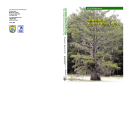What We Do
Refuge staff use a variety of tools to manage wildlife populations and habitat on Lake Ophelia NWR while maintaining opportunities for the public to participate in recreational activities like hunting and fishing.
Water Management
Because Lake Ophelia NWR was established for wintering waterfowl, and because it is within the floodplain of the Mississippi River, water management is the most important management tool for the refuge’s resources. Water levels are actively managed on nearly 1,500 acres of refuge impoundments or shallow water pools. Levels are managed to provide a variety of wetland conditions to produce plants for ducks, mudflat for shorebirds, and shallow water for wading birds. By raising and lowering water levels throughout the year, refuge staff has the ability to simulate natural and dynamic wetland cycles.
Cooperative Farming
Lake Ophelia NWR has an active cooperative farming program for the primary purpose of providing food and other needed habitats for waterfowl and other wildlife. Through a cooperative farm agreement, the farmer utilizes a portion of the refuge to plant crops and leaves or plants unharvested grain crops for refuge wildlife as rent. Utilizing the farmer to manage early succession habitat and provide high energy foods for ducks and geese, this program allows the refuge to fulfill its purpose efficiently and successfully.
Deer Harvest Management
Deer hunting is a significant public use on Lake Ophelia NWR but is also used to manage the deer herd and as a result provide healthy habitat. Deer populations should be reduced to under carrying capacity or at a density that the habitat can support. Removing a portion of the herd annually with the appropriate age structure and sex ratios should result in a healthy herd.
Management and Conservation
Refuge conservation plans are called “comprehensive conservation plans” (CCPs). The purpose of a CCP is to specify a management direction for the Refuge for the next 15 years. The goals, objectives, and strategies for improving Refuge conditions—including the types of habitat we will provide, partnership opportunities, and management actions needed to achieve desired conditions – are described in the CCP. From there, various step-down plans guide the day-to-day workings of the Refuge.
Our Services
The refuge is open from sunrise to sunset. Roads throughout the refuge are graveled and visitors must maintain the posted speed limits. Parking is allowed in designated parking areas only. No overnight parking is allowed on the refuge. Hiking is allowed in all areas open to the public. Wildlife observation and photography are encouraged. Please stay out of closed areas to minimize disturbance to plants and animals. Horseback riding is not authorized on the refuge. Fishing and hunting is allowed on over 12,000 acres of the refuge. Special refuge regulations apply.
Please contact the refuge office 318-253-4238.
Law Enforcement
For emergencies, CALL 9-1-1!
To report refuge violations call (318) 253-4238 or the Louisiana Department of Wildlife and Fisheries 24-Hour line at 1-800-442-2511.
Laws and Regulations
Law enforcement is essential to virtually every aspect of wildlife conservation. The law enforcement officers contribute to Service efforts to manage ecosystems, save endangered species, conserve migratory birds, preserve wildlife habitat, restore fisheries, combat invasive species invasive species
An invasive species is any plant or animal that has spread or been introduced into a new area where they are, or could, cause harm to the environment, economy, or human, animal, or plant health. Their unwelcome presence can destroy ecosystems and cost millions of dollars.
Learn more about invasive species , and promote international wildlife conservation.

